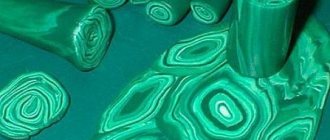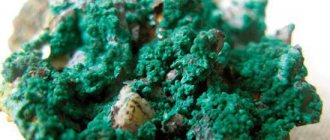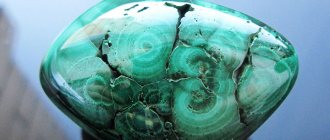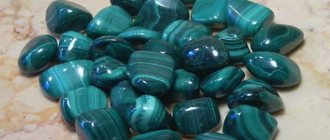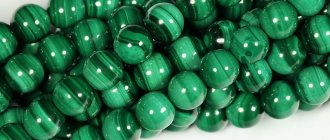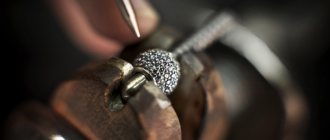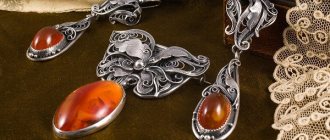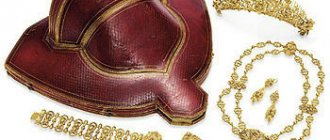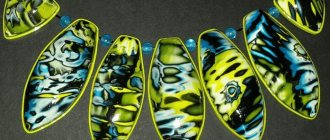Malachite is a stone that is one of the first gems known to mankind since ancient times. For thousands of years, it was the main copper ore, from which copper was smelted from the beginning of the Bronze Age until the 17th-18th centuries, when a replacement was found. Since that time, malachite began to be valued as an ornamental stone.
The name "malachite": origin
The roots of the word “malachite” go back to the Greek language. There are two versions of the interpretation of this noun. According to one, the Greeks called the stone this way because of its rich color - μολόχα - “green flower”. Another version says that the name comes from the word μαλακός - “soft”.
Indeed, malachite is distinguished by its fragility; it is unstable to external influences. Jewelers claim that real Ural malachite loses color and becomes dull, even if dust just sits on it! It is noted that the softness of this mineral can also turn into its advantage. After all, malachite lends itself well to polishing and grinding.
History of the stone
The oldest malachite jewelry was found in Iraq 10.5 thousand years ago. And in Israel, malachite beads were found that are nine thousand years old. In Ancient Rome, malachite was used to create amulets and amulets. This mineral was extremely popular in China and India. In addition, it was used to make paints that did not lose their brightness for a long time. Proof of this are the tombs of the pharaohs. And beauties from Ancient Egypt made eye shadow from malachite powder.
Care instructions
The gem dissolves in acids and does not tolerate temperature fluctuations, extreme heat, or household chemicals.
It is sensitive to hot water, so jewelry with malachite is cleaned with warm soapy water.
Malachite box
Products made from ornamental stone are not accepted by everyone. But it’s hard to resist the charms of the malachite box. Its energy, even if it is a fused crumb, will heal other gems and elite stones. Such a thing is worth purchasing, because there is less and less malachite on Earth, which means that the price is not expected to become cheaper.
Ural malachite: history of fishing in Russia
Until the 18th century, malachite was found only in the form of small nuggets. This mineral became popular only after the development of the Ural deposits began in Russia. It was Russian miners who were able to find blocks of the mineral that weighed several hundred tons. But the heaviest block weighed 250 tons. It was discovered in 1835.
The first malachite deposit was discovered in the forties of the 18th century. It is called Gumeshevskoe and is located at the source of the Chusovaya River. Thanks to the opening of that mine, the production of small jewelry began in Russia. Rings and beads, earrings and pendants - the Ural malachite stone was usually used together with other stones, most often precious.
The flourishing of the fishery began after the discovery of the Mednorudnya deposit. It was then that a unique style of making products from this stone appeared, which was called Russian mosaic. Skilled stone cutters sawed the stones into the thinnest plates, selected patterns and glued them onto the base. Then the grinding process began. Russian craftsmen created such Ural products from malachite that not a single observer could even doubt the solidity of the products.
The reserves of Ural malachite were so rich that some craftsmen could afford to handle this mineral carelessly. There are known cases when malachite chips, which craftsmen refused to work with, were used to fill up holes in pavements. Today, such extravagance seems like real madness, because even the smallest samples are a real miracle.
The year 1726 was marked by the appearance of the first malachite processing workshop in the Urals. And in 1765, by decree of Catherine the First, the first factory of Ural malachite was opened - the Yekaterinburg Lapidary Factory. It was at the same time a complex for the extraction and processing of this stone, a center for stone cutting and an educational institution for several generations of craftsmen.
The most beautiful Russian folk art
Folk crafts are exactly what makes our culture rich and unique.
Foreign tourists take with them painted objects, toys and textile products in memory of our country. Almost every corner of Russia has its own type of needlework, and in this material we will look at the brightest and most famous of them. Dymkovo toy
The Dymkovo toy is a symbol of the Kirov region, emphasizing its rich and ancient history. It is molded from clay, then dried and fired in a kiln. After that, it is painted by hand, each time creating a unique copy. There cannot be two identical toys. This is one of the oldest Russian crafts, which Vyatka craftsmen have been practicing for 400 years. The appearance of the toy is associated with the spring holiday of Whistling, when clay whistles in the form of lambs, horses, goats or ducks came out of the hands of the women of the Dymkovo settlement. In the 30s of the 20th century, not only a large number of variations of spring toys on the theme of everyday life and fairy tales appeared, but also many new ornaments and color combinations were developed. Each toy is unique and one of a kind, because it is sculpted and painted by a master every time anew. At the same time, there are no analogues of this clay miracle in the world.
Zhostovo painting
At the beginning of the 19th century, the Vishnyakov brothers lived in one of the Moscow villages of the former Troitskaya volost (now Mytishchi district), and they were engaged in painting lacquered metal trays, sugar bowls, pallets, papier-mâché boxes, cigarette cases, teapots, albums and other things. Since then, artistic painting in the Zhostovo style has begun to gain popularity and attract attention at numerous exhibitions in our country and abroad.
Khokhloma
Khokhloma is one of the most beautiful Russian crafts, which originated in the 17th century near Nizhny Novgorod. This is a decorative painting of furniture and wooden utensils, which is loved not only by connoisseurs of Russian antiquity, but also by residents of foreign countries. Khokhloma painting appeared in the village of Khokhloma, on the left bank of the Volga. However, there are a large number of other versions of the appearance of this ancient folk craft. Traditional juicy rowan berries in gilded leaves on a black background are unlikely to leave anyone indifferent. Later, images of birds, fish and animals were added with floral ornaments. The intricately intertwined herbal patterns of bright scarlet berries and golden leaves on a black background can be admired endlessly. Therefore, even traditional wooden spoons, presented on the most insignificant occasion, leave the recipient with the kindest and longest memory of the donor.
Gorodets painting
Gorodets painting has existed since the mid-19th century. Bright, laconic patterns reflect genre scenes, figurines of horses, roosters, and floral patterns. The painting is done in a free stroke with a white and black graphic outline; it decorates spinning wheels, furniture, shutters, and doors.
Ural malachite
Known deposits of malachite are in the Urals, Africa, South Australia and the USA, but in terms of color and beauty of patterns, malachite from foreign countries cannot be compared with that from the Urals. Therefore, malachite from the Urals is considered the most valuable on the world market.
Gusev crystal
Products made at the Gus-Khrustalny crystal factory can be found in museums all over the world. Traditional Russian souvenirs, household items, sets for the festive table, elegant jewelry, boxes, and handmade figurines reflect the beauty of our native nature, its customs and primordially Russian values. Products made from colored crystal are especially popular.
Matryoshka
A chubby and plump cheerful girl in a headscarf and Russian folk dress won the hearts of lovers of folk toys and beautiful souvenirs around the world. Matryoshka (from the diminutive name “Matryona”) is a Russian wooden toy in the form of a painted doll, inside of which there are smaller dolls similar to it. Nowadays, the nesting doll is not just a folk toy, a keeper of Russian culture: it is a memorable souvenir for tourists, on the apron of which play scenes, fairy tale plots and landscapes with attractions are finely drawn. The nesting doll has become a precious collectible that can cost hundreds of dollars.
Enamel
Vintage brooches, bracelets, pendants, which quickly “entered” modern fashion, are nothing more than jewelry made using the enamel technique. This type of applied art originated in the 17th century in the Vologda region. Masters depicted floral patterns, birds, and animals on white enamel using a variety of paints. Then the art of multi-color enamel began to be lost, and monochromatic enamel began to supplant it: white, blue and green. Now both styles are successfully combined.
Tula samovar
In his free time, Fyodor Lisitsyn, an employee of the Tula Arms Factory, loved to make something out of copper, and once made a samovar. Then his sons opened a samovar establishment where they sold copper products, which were wildly successful. The Lisitsyn samovars were famous for their variety of shapes and finishes: barrels, vases with chasing and engraving, egg-shaped samovars, with dolphin-shaped taps, with loop-shaped handles, and painted ones.
Palekh miniature
A small town in the Ivanovo region, Palekh, has been famous for its icon painting craft for a long time. Since the time of the Tatar-Mongol yoke, small “pysanka” icons, which could be easily hidden, have been in great demand. In the middle of the 17th century, Palekh works reached Moscow, and craftsmen began to be invited to work - the Chamber of Facets in the Kremlin, the Trinity Lavra of St. Sergius, and the Novodevichy Convent were decorated with Palekh icons. In the 20th century, Palekh masters were forced to change the subject matter of their works - Pushkin’s fairy tales, scenes from rural life, revolutionary motifs. Palekh miniature is a special, subtle, poetic vision of the world, which is characteristic of Russian folk beliefs and songs. The painting uses brown-orange and bluish-green tones. Palekh painting has no analogues in the whole world. It is done on papier-mâché and only then transferred to the surface of boxes of various shapes and sizes.
Gzhel
The Gzhel bush, an area of 27 villages located near Moscow, is famous for its clay, which has been mined here since the mid-17th century. In the 19th century, Gzhel craftsmen began to produce semi-faience, earthenware and porcelain. Of particular interest are still items painted in one color - blue overglaze paint applied with a brush, with graphic detailing.
Pavloposad shawls
Bright and light, feminine Pavloposad shawls are always fashionable and relevant. This folk craft appeared at the end of the 18th century at a peasant enterprise in the village of Pavlovo, from which a shawl manufactory subsequently developed. It produced woolen shawls with printed patterns, which were very popular at that time. Nowadays, original designs are complemented by various elements such as fringe, are created in different colors and remain an excellent accessory to almost any look.
Vologda lace
Vologda lace is woven on wooden sticks and bobbins. All images are made with dense, continuous, uniform width, smoothly curling linen braid. They stand out clearly against the background of patterned lattices, decorated with elements in the form of stars and rosettes.
Shemogodskaya carved birch bark
Shemogodskaya carving is a traditional Russian folk art craft of birch bark carving. The ornaments of Shemogod carvers are called “birch bark lace” and are used in the manufacture of boxes, teapots, pencil cases, cases, dishes, plates, and cigarette cases. The symmetrical pattern of Shemogod carving consists of floral patterns, circles, rhombuses, and ovals. The drawing can include images of birds or animals, architectural motifs, and sometimes even scenes of walking in the garden and drinking tea.
Tula gingerbread
Tula gingerbread is a Russian delicacy. Without these sweet and fragrant products, not a single event took place in Rus' - neither funny nor sad. Gingerbread was served both at the royal table and at the peasant table. The traditional shape is given to the gingerbread using a board with a carved ornament.
Orenburg downy shawl
The scarves are knitted from natural goat down and are amazingly soft, beautiful, warm and practical. Openwork web scarves are so thin and elegant that they can be threaded through a wedding ring. They are valued by women all over the world and are considered a wonderful gift.
Happy RUSSIA Day!!!
Popularity of the mineral
This stone became a decoration for the houses of Russian and European nobility. It was even used for cladding rooms, for example, the Malachite Living Room of the Winter Palace. The artistic value of this masterpiece of Russian architecture is difficult to overestimate. The pattern is chosen so skillfully that the joints between the plates are completely impossible to see. The columns of St. Isaac's Cathedral were also lined with malachite. In the chambers of wealthy people one could find such items as a vase made of Ural malachite, watches, snuff boxes, caskets, and even fireplaces and tabletops made of this mineral.
By the way, at that time it was very fashionable to collect interesting samples of various minerals, including malachite. The nobility even competed with each other. Empress Catherine II rightfully received the title of owner of the best collection.
Types of malachite
There are two types of Ural malachite - plush and turquoise. Plush malachite is fragile and therefore less amenable to processing. It is not used to create jewelry. Most often, this species is of interest to mineralogists. Amateurs and experts collect samples of this mineral. The more common type of malachite is turquoise. Its structure is unique: a bizarre pattern is created by asymmetrical stripes and circles. Unique green patterns are valued by both collectors and jewelers.
The end of the malachite era
At the end of the 19th century, this delightful mineral became available not only to very wealthy people, but also to nobles. Competitions regarding the number of malachite items in homes have ceased, and the mineral has become less used in interiors. Malachite began to be used to make paint that covered the roofs of houses.
The revolution of 1917 led to the fact that stone mining decreased significantly. This was due to the fact that the two main deposits - Mednorudnyanskoye and Gumeshevskoye - were severely depleted. At the end of the 19th century, the Gumeshevskaya mine was seriously flooded. That’s why now this place is visited exclusively by extreme sports enthusiasts. The Mednorudnyanskoe deposit is still functioning, but it is not malachite that is mined here, but copper ore. Today, Ural malachite is practically never found here, and therefore is valued more and more.
STRUCTURE
Malachite is one of the main copper minerals, containing 57.4% pure metal. In addition to copper, it contains oxygen, carbon and water. In composition, malachite is an aqueous copper carbonate salt – Cu(OH)2·CuCO3. Malachite contains up to 72% copper oxide, which is why it was used as copper ore. Malachite crystallizes in a monoclinic system, a prismatic type of symmetry. The color of malachite is due to the presence of copper ion. As a result of the interaction of copper-sulfate solutions with carbonate or carbon dioxide waters, malachite is formed.
Malachite case today
The Urals are far from the only place in the world where malachite deposits have been discovered. Development is also underway in Altai. By the way, sometimes there are samples of Altai malachite, which in terms of beauty and fancy rings are practically no different from samples of the Ural mineral. The modern leader in the supply of malachite is the Republic of Congo. The malachite mined here differs from the Ural one in its pattern, consisting of even stripes. The mineral is mined in the UK, Chile, Australia, France and Cuba. However, the stones mined in these mines are significantly inferior in their external qualities to Ural malachite.
Does malachite from the Urals have a future?
Experts have found that all the world's reserves of malachite can be classified as one type, and the appearance of the mineral is associated with the zonal oxidation of copper ores. That is, the likelihood that new malachite deposits can be found in the Urals is extremely high.
For several years, Grigory Nikolaevich Vertushkov, a professor at Sverdlovsk University, has been collecting information that is somehow related to copper and malachite deposits. He is sure that the researchers were mistaken and in fact the reserves of the Ural mines are not depleted. Grigory Nikolaevich claims that in two deposits deep reserves of this unique mineral have not been touched.
Zodiac signs
Malachite is ideal for those born under the sign of Libra, Taurus, Leo and Virgo. It will help these signs realize their creative potential, smooth out negative character traits, and give them luck and joy.
But for Cancers and Pisces, Malachite is contraindicated, since it can develop arrogance in them and incline them to unjustified risks and reckless actions, provoking troubles with the law and in relationships with others.
The most famous malachite products
The Malachite Hall mentioned above is simply a treasure trove of products made from this mineral. Here you can see vases and tables, bowls and columns. Everything took about two hundred poods (by the way, 1 pood is 16.38 kg). Almost all the products here are made in the “Russian mosaic” style. 1,500 pounds of malachite were needed to line the columns of the largest Orthodox church in St. Petersburg - St. Isaac's Cathedral.
In the Pitti Palace, located in Florence, there is a malachite table, preserved from the heyday of the malachite craft in Russia. An incredible collection of objects was made for the London Exhibition in 1851: doors, tables and chairs, grandfather clocks, vases and a fireplace.
How to distinguish real malachite from a fake?
Ural malachite, the photo of which you have already seen, is very popular, and therefore its synthetic analogue has appeared on the market. To create a fake, plastic and glass are used.
How to distinguish a natural stone from a fake?
- Real malachite is cool to the touch. Plastic imitation – warm.
- Glass stone is distinguished by the presence of transparent inclusions on the surface.
- Imitations, which are made on the basis of other stones with the addition of painting and varnish, can be distinguished from natural stone by dropping ammonia on them: real malachite will acquire a blue tint, but the fake will not change.
- You can also distinguish genuine Ural malachite from a fake using vinegar or lemon juice. True, the surface of a natural stone after such a check will begin to bubble strongly.
Jewelry
At first glance, the malachite gem seems bulky for fashion accessories, but this is not so. Jewelry of all types is created from valuable specimens.
The patterned surface of malachite makes each product exclusive.
The stone is framed with gold, cupronickel, copper. All shades of green look most impressive in silver.
Gold earrings and ring with malachite
Beads and bracelets of a classic round shape are in demand more than other products. They are almost always frameless; there are options with decorative metal overlays.
Sets of rings and earrings attract attention, creating a highlight in a woman’s image.
Malachite is combined in products with the same dense, low-transparent gems: agate, turquoise, coral, quartz, and onyx.
Its relative softness does not allow it to be cut with high quality, so the links of beads, bracelets, inserts of rings, and earrings are given soft outlines.
Magical and healing properties of Ural malachite
They began to endow the green mineral with magical properties back in the Middle Ages. Small pieces of malachite were hung over a baby's crib, in the belief that they would ward off evil spirits and the baby would sleep peacefully. To protect an adult, malachite was engraved, usually in the form of the sun.
It was believed that malachite was a good helper in love rituals. It was often mentioned in fortune telling and magic books as a means of attracting love and keeping it. Traditional healers used malachite to treat allergies and skin diseases, asthma and migraines.
MORPHOLOGY
Well-formed crystals are very rare and always small, have a columnar, lamellar, needle-like appearance, and tend to split to form bundles, fluffy balls, spherocrystals, spherulites, spheroidolites and spheroidolite dendrites. Usually forms kidney-shaped fine-fibrous spherulite aggregates with a radial-radiating structure and concentric-zonal texture, spheroidolite cluster-shaped dendrites, pseudostalactites. Also leafy, dense or earthy in composition, sometimes in the form of parallel columnar aggregates (Dzhezkazgan deposit). The most characteristic and well-known are spherulitic fine-fiber concentric-zonal kidney-shaped aggregates (see photo). They grow from highly supersaturated nonequilibrium solutions.
